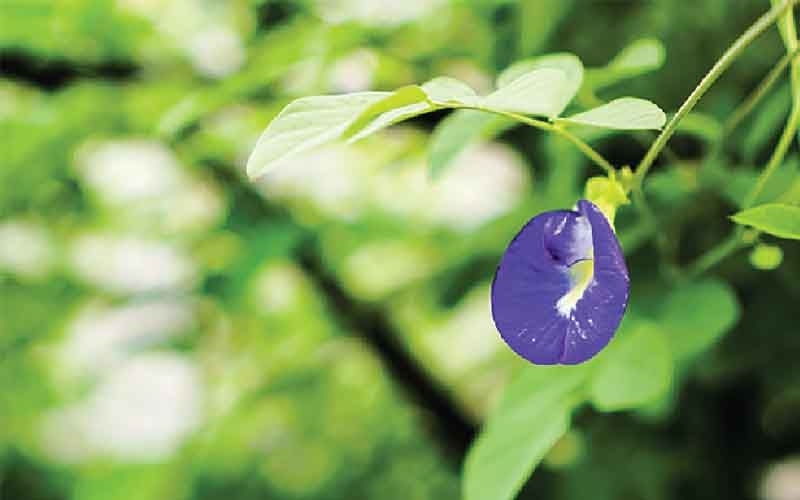APARAJITA : A MENTAL TONIC

Dr. Saryu Trivedi
Dept. of Floriculture and
Landscape Architecture
ASPEE College of Horticulture
Navsari Agri. Uni. Navsari, Gujarat.
Clitoria ternatea commonly known as Butterfly pea is a medicinal plant belonging to the family Fabaceae. The plant is reported to be used in insect bites, skin diseases, asthma, burning sensation, ascites, inflammation, leucoderma, leprosy, hemicrania, amentia and pulmonary tuberculosis. It is commonly called “Shankpushpi” in the Sanskrit language where it is reported to be a good “Medhya” (brain tonic).
The major phytoconstituents found in Clitoria ternatea are the pentacyclic triterpenoids such as taraxerol and taraxerone, ternatins, alkaloids, flavonoids, saponins, tannins, carbohydrates, proteins, resins and starch. Clitoria ternatea has been evaluated for its medicinal properties and shows promising effects as having antioxidant, antidiabetic and hepatoprotective activities. This flowering plant is native to Southeast Asia but is now found in various tropical and subtropical regions around the world. The name “Aparajita” is of Sanskrit origin and means “undefeated” or “invincible.”
Plant Description
Clitoria ternatea has twining fine stems, 0.5-3 m long. The leaves are pinnate, with 5-7 elliptic to lanceolate leaflets, 3-5 cm long and shortly pubescent underneath (Fig. 1). Flowers are solitary, deep blue to blue mauve; very short pedicellate and 4-5 cm long (Fig. 2). Pods are flat, linear, beaked, 6-12 cm long, 0.7-1.2 mm wide and slightly pubescent with up to 10 seeds. The seeds are olive, brown or black in colour, often mottled, 4.5-7 mm long and 3-4 mm wide.
History
From ancient times “Shankhpushpi” is known as reputed drug of Ayurveda and reported as a brain tonic, nervine tonic and laxative. It is considered as a “Medhya- Rasayana” in Ayurvedic texts. It comprises of entire herb with following botanicals viz. Convolvulus pluricaulis (Convolvulaceae), Evolvulus alsinoides (Convolvulaceae), Clitoria ternatea (Papilionaceae) and Conscora decusata (Gentianaceae). It is an Ayurvedic drug used for its action on the CNS (Central Nervous System), especially for boosting memory and improving intellect. The flowers of the plant Clitoria ternatea resemble a conch shell; therefore it is commonly called “Shankpushpi” in the Sanskrit language where it is reported to be a good “Medhya” (brain tonic) drug and, therefore, used in the treatment of “Mansika Roga” (mental illness). Extracts of this plant have been used as an ingredient in Medhya- Rasayana, are juvenating recipe used for treatment of neurological disorders.
Here are some key features and uses of Aparajita (Clitoria ternatea):
Flower Appearance: The butterfly pea flower is known for its unique appearance. The most common variety has bright blue petals with a distinct shape that resembles a butterfly. There are also varieties with white and purplish-pink flowers.
Culinary Uses: In some cultures, the butterfly pea flower is used as a natural food coloring. It imparts a blue or purple hue to foods and beverages. The flowers are sometimes used to color rice, desserts, and drinks.
Herbal Tea: Butterfly pea flowers are popularly used to make a vibrant blue herbal tea. When the dried flowers are steeped in hot water, they release compounds that give the tea its distinctive color. Adding citrus juice, such as lemon, can change the PH and turn the tea purple.
Traditional Medicine: In traditional medicine, various parts of the butterfly pea plant are believed to have medicinal properties. It has been used in Ayurveda and traditional Southeast Asian medicine for its potential health benefits.
Garden Ornamental: Besides its practical uses, Aparajita is also cultivated for ornamental purposes. The attractive flowers make it a popular choice for gardens and landscapes.
Nitrogen Fixation: The butterfly pea is a leguminous plant, which means it has the ability to fix nitrogen in the soil through a symbiotic relationship with nitrogen-fixing bacteria. This can contribute to soil fertility.
Symbolism: The name “Aparajita” and the butterfly pea flower, in general, are associated with symbols of victory, success and purity in various cultures.


